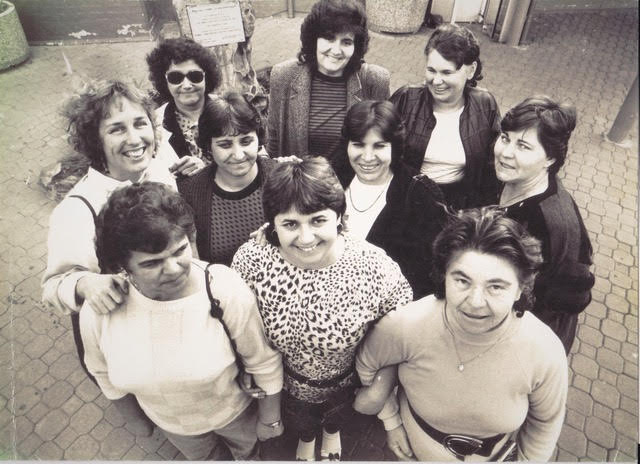Women of Steel: a documentary film
by Robynne Murphy
Reviewed by Diane Hague
Women of Steel is a remarkable film about an epic struggle between a small group of women and one of Australia’s largest companies. The film is a documentary about the Jobs for Women campaign in Wollongong between 1980 and 1991. A small group of women decided to take on Australian Iron and Steel (AIS, a subsidiary of BHP) for the right to be employed in the better-paid jobs that only men got. While the situation had been longstanding, impetus to the campaign was provided by the passing of the NSW Anti-Discrimination Act (the ADA) in 1977, and activity arising from this.
There are themes in this documentary which still resonate today. An alliance was built between the socialist left and migrant women who had come to Australia after WWII. Migrant women, in particular, were keen to work at the steelworks. They had held similar jobs in the countries they had come from during the war, as indeed did Australian women in wartime. But in Wollongong in the early 1980s the only available factory work was in the clothing trade. In the steelworks, the only jobs for women were in the canteen and cleaning, which earned much less than the jobs held by men.
Young women made up two thirds of the youth unemployed in Wollongong. Where they did manage to find work, they were highly vulnerable, subject to unscrupulous employers. One such case, where a shop owner regularly threatened his young women employees with the sack if they did not agree to sex, particularly resonates today. One of the young women, who came from a union background, told her parents. In a union town like Wollongong, it was perhaps not surprising that the shop owner was forced to leave.
The length of the campaign as depicted in the film also resonates. When women take on a serious campaign, they understand that it could take a long time – and these women were tenacious. They were not going to let all the work that had been done go for nothing!
The film was initiated by Director/Producer Robynne Murphy, a lifelong activist who had trained in film but instead became prominent in the Jobs for Women campaign at the Port Kembla steelworks and, ultimately, a career steelworker. Murphy provides the linking narrative throughout the film, and a fine balance is maintained between her dual perspectives, as film-maker and as participant in the events being recorded.
Murphy was determined to track down as many as possible of the women who had initiated the campaign and was lucky to find many of them. Her interviews with the migrant women in particular are fresh and very moving. It is wonderful to see how this campaign impacted on these women’s lives. So many years later they remember it with such clarity. Oral history is so important as it brings to life events by hearing from the people who were involved.
It’s extraordinary how much archival footage has survived; lots of photographs but also film, and it is used to good effect. Interviews with the women link the photos and film and clearly demonstrate to us, the audience, how determined these women were to win. We see how the campaign develops from small beginnings, such as Jobs for Women campaigners setting up a table outside the steelworks and getting the men to sign a petition supporting the cause, to large demonstrations and sit-ins outside NSW Parliament. The links provided by the interviews keep the story fresh and tight.
At BHP’s steelworks reception desk there was a list, built up over years, of the names of 2,300 women seeking jobs, which was not acted upon until the first case was won. But in 1983, with the women’s move into available jobs well underway, BHP declared a slashing of the workforce in which the old and established policy of ‘last on, first off’ applied, so the women were the first to lose their jobs.
However, some of the women had put their names on the list as long as nine years previously and held that, if BHP had been doing the right thing, they would have been employed years before. And so a further campaign was launched through the Counsellor for Equal Opportunity under the ADA, in which the women argued that application of the ‘last on, first off’ principle was discriminatory because of BHP’s earlier discriminatory failure to appoint them.
I find the footage still available from this campaign most remarkable. We can watch the women with Carmel Niland, Counsellor for Equal Opportunity, discussing what they have to do to take the case to the Equal Opportunity Tribunal and doing their preparation. All the preparation was worth it as Jobs for Women went on to beat BHP at the Tribunal and we see their representatives stream smiling out of the Tribunal. Of course, BHP appealed, ultimately to the High Court, but it lost.
This is a joyous film. It shows that it doesn’t matter how big your dreams are and how few people dream with you in the beginning, you can take on the largest of vested interests and you can win. It might take time but it can be done. It is definitely a film worth seeing and I hope it gets the viewings it deserves.
Diane Hague was a union activist from the 1970s onwards, firstly in the NSW public service and subsequently with the NSW Teachers Federation after she began teaching in TAFE. After many years working as a union official with the Federation, she is now retired and lives on the mid North Coast of NSW.
Women of Steel is being screened across the country, with regional tours underway. To find out about screenings in your area or to organise your own screening, check:
https://fan-force.com/films/women-of-steel/
